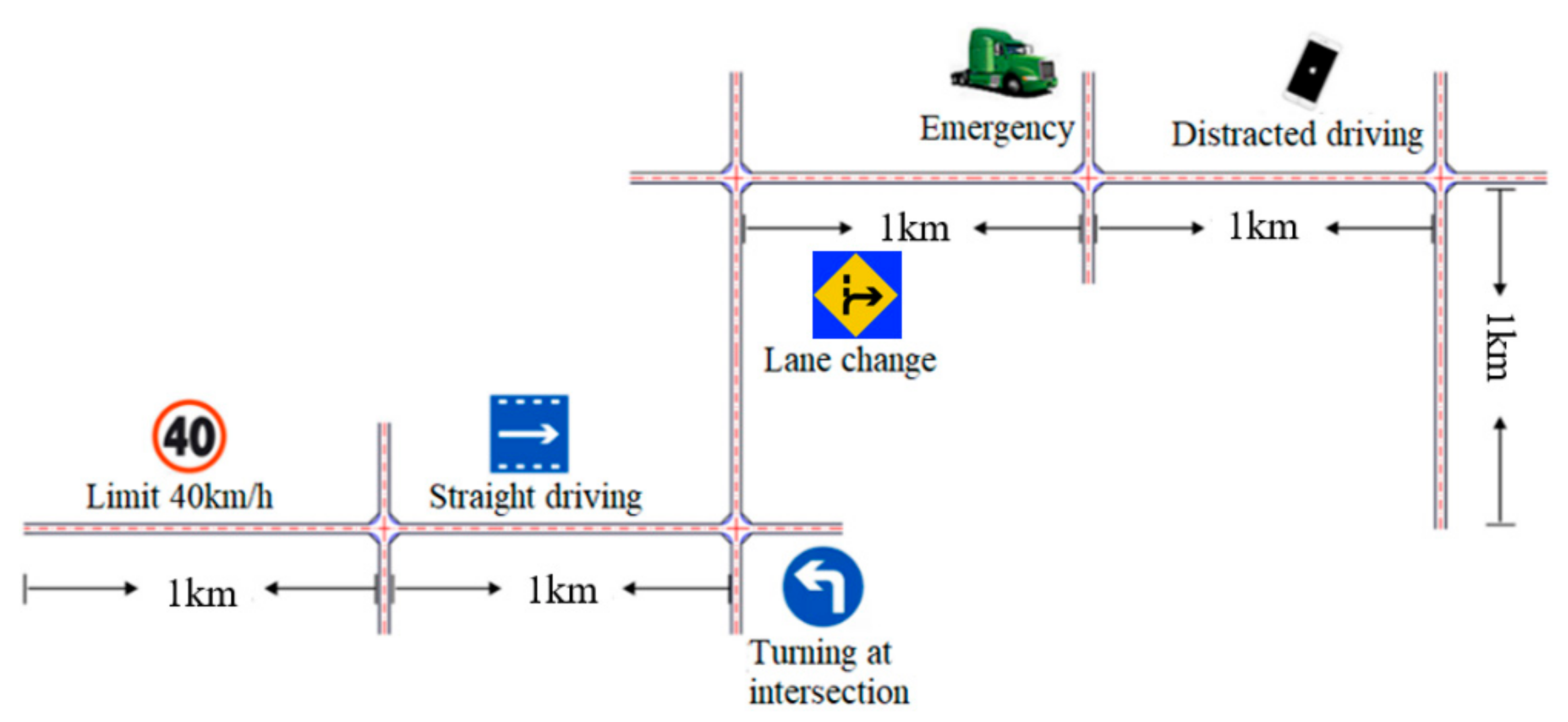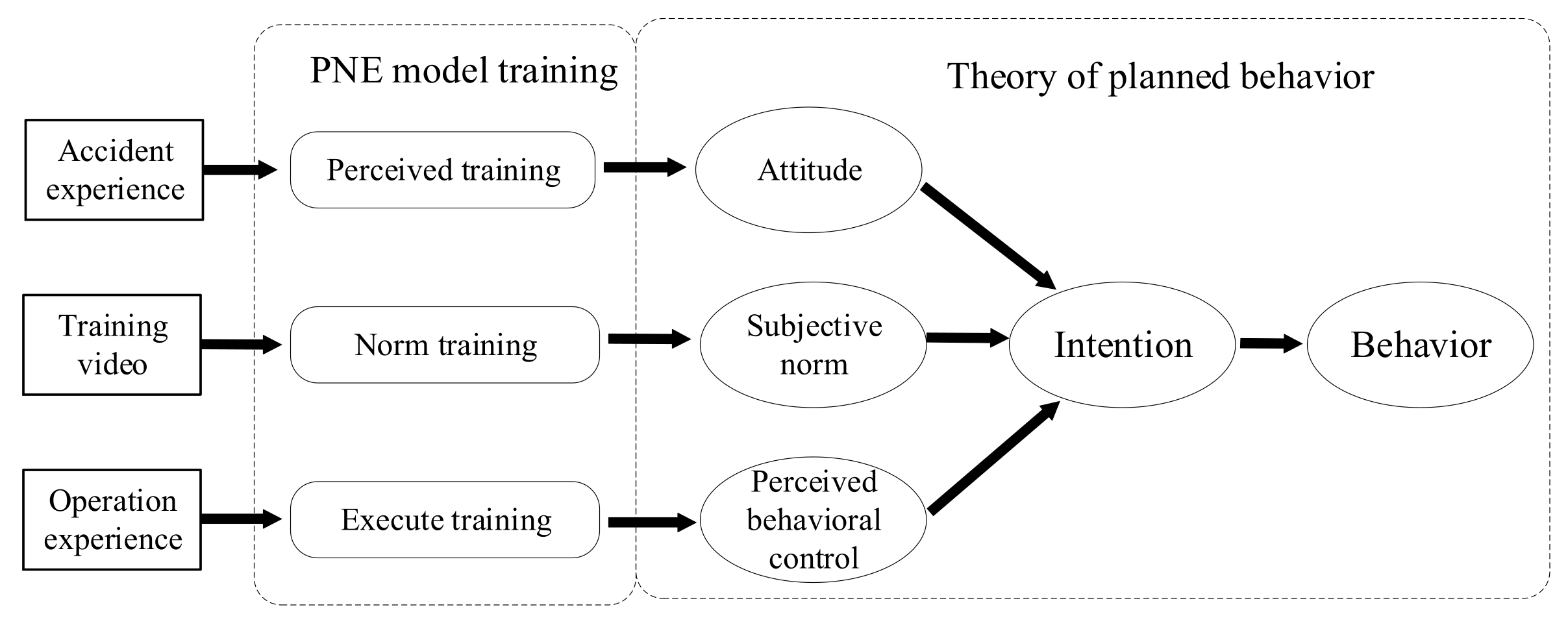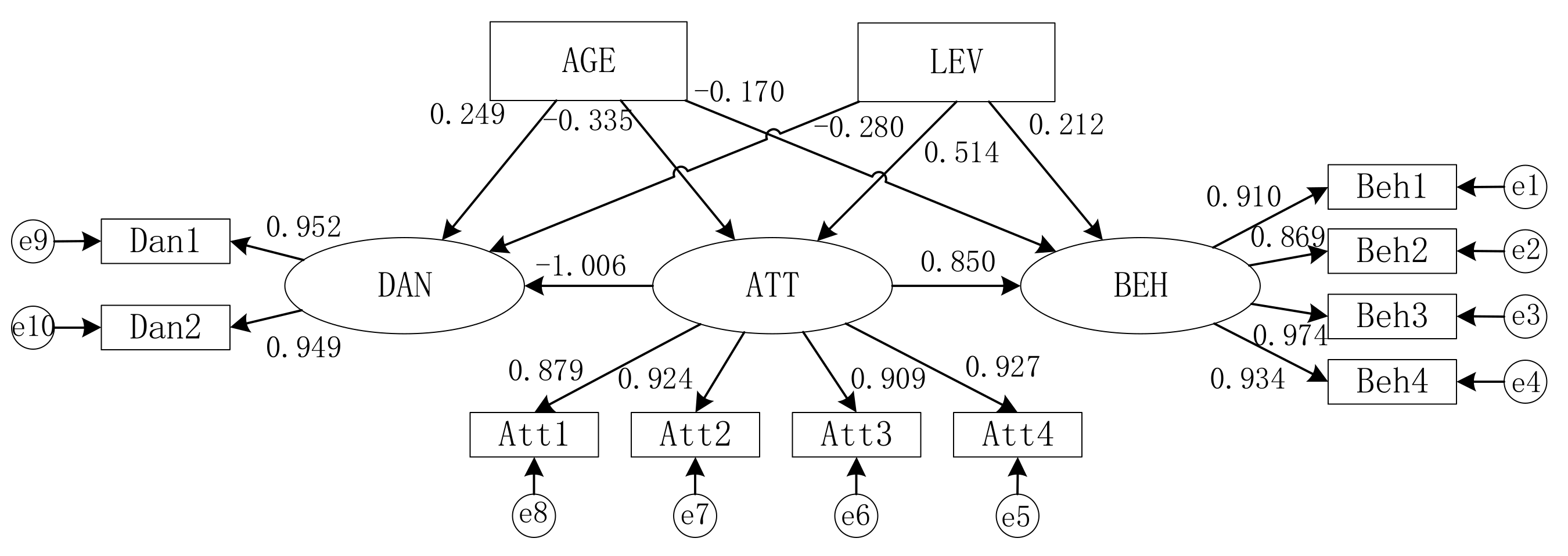Improving Older Drivers’ Behaviors Using Theory of Planned Behavior
Abstract
1. Introduction
2. Experimental Design
2.1. Construction of Experimental Route
- (1)
- Experimental scenario for comparative analysis of driving behavior characteristics
- Straight driving: low traffic flow, no dangerous vehicles or pedestrians, the driver is required to drive using their normal driving habits.
- Turning at intersection: no signal intersection with medium traffic flow, the driver is required to drive using their normal driving habits; there are oncoming conflict vehicles driving straight and turning left in the vision of the driver.
- Lane change: low traffic flow, no dangerous vehicles or pedestrians, the driver is required to change to the right lane using their normal driving habits.
- Emergency: low traffic flow, with the driver driving from west to east and entering the trigger zone, a large truck driving into the intersection from south to north out of the driver’s field of vision, the driver’s vision is blocked by vehicles parked on the roadside, resulting in a serious conflict with the driver’s vehicle.
- Distracted driving: low traffic flow, the driver is required to telephone someone who they are familiar with through the handheld mobile phone, while a pedestrian is crossing the road from the pavement.
- (2)
- Training experimental scenarios of driving behavior characteristics.
- Straight driving: low traffic flow, the driver is required to drive using their normal driving habits, and a bicycle crosses the road in front of the driver when they enter the trigger zone along the road.
- Turning at intersection: no signal intersection with a low traffic flow, the driver turned from north to east, and a large truck drives from east to west when the driver’s vehicle enters the trigger zone.
- Lane change: low traffic flow, a bicycle crosses the road in front of the driver when they changed lane to right.
- Emergency: no signal intersection with low traffic flow, a large truck drives from west to east when the driver turns from south to east.
- Distracted driving: low traffic flow, the driver is required to call someone who they are familiar with, and there is a pedestrian crossing the road from the pavement.
2.2. Participants
2.3. Conduct of Experiment
2.4. Experimental Data
3. Method
3.1. Materials and Apparatus
3.2. Theory of Planned Behavior (TPB)
- (1)
- Attitude of behavior (AB)
- (2)
- Subjective norm (SN)
- (3)
- Perceived behavior control (PBC)
- (4)
- Behavior intention (BI)
3.3. PNE Model
3.4. Structure Equation Model (SEM)
4. Results
4.1. Difference in Driving Behavior Indicators
4.2. Driving Behavior Training Model Based on TPB
4.3. Structural Equation Model (SEM)
5. Discussion
5.1. Driving Behavior Characteristics
5.2. PNE Driver Training Model
5.3. Analysis of Structural Equation Model (SEM)
6. Conclusions
Author Contributions
Funding
Institutional Review Board Statement
Informed Consent Statement
Data Availability Statement
Acknowledgments
Conflicts of Interest
References
- National Bureau of Statistics of China. China Statistical Yearbook of 2020; China Statistics Press: Beijing, China, 2020.
- José, P.; Gregorio, B.; Juan, H.; Eladio, J.; María, M.; Sjoerd, H.; Pablo, L.-C. The role of exposure on differences in driver death rates by gender and age: Results of a quasi-induced method on crash data in Spain. Accid. Anal. Prev. 2016, 94, 162–167. [Google Scholar] [CrossRef]
- Elena, S.R.; Katherine, P.; Marta, O.; Ana, M.N. Gender differences in road traffic injury rate using time travelled as a measure of exposure. Accid. Anal. Prev. 2014, 65, 1–7. [Google Scholar] [CrossRef]
- Zhou, C.; Li, C.; Shen, X.T.; Wang, X.S. Review of driving self-regulation in older adults. China J. Highw. Transp. 2020, 33, 18–28. [Google Scholar] [CrossRef]
- Moon, S.H.; Park, K. The Predictors of Driving Cessation among Older Drivers in Korea. Int. J. Environ. Res. Public Health 2020, 17, 7206. [Google Scholar] [CrossRef]
- Song, W.; Woon, F.L.; Doong, A.; Persad, C.; Tijerina, L.; Pandit, P.; Cline, C.; Giordani, B. Fatigue in Younger and Older Drivers: Effectiveness of an Alertness-Maintaining Task. Hum. Factors 2017, 59, 995–1008. [Google Scholar] [CrossRef]
- Thorslund, B.; Nygårdhs, S.; Malicka, A.; Black, A.; Hickson, L.; Wood, J. Exploring older adults hearing and vision and driving—The Swedish study. Transp. Res. Part F Traffic Psychol. Behav. 2019, 64, 274–284. [Google Scholar] [CrossRef]
- Guo, F.X.; Xiong, C.A.; Wan, H.S.; Ni, D.A. Behavior characteristics of older drivers based on risk perception. China J. Highw. Transp. 2021, 34, 309–321. [Google Scholar] [CrossRef]
- Yuan, W.; Fu, R.; Guo, Y.S. Characters of Driver’s Eye Movements on Urban Roadways. J. Transp. Inf. Saf. 2013, 31, 117–122. Available online: http://en.cnki.com.cn/Article_en/CJFDTotal-JTJS201301026.htm (accessed on 10 September 2021).
- Ma, Y.; Fu, R. Research and development of drivers visual behavior and driving safety. China J. Highw. Transp. 2015, 6, 86–98. [Google Scholar] [CrossRef]
- Rogé, J.; Pébayle, T. Deterioration of the useful visual field with ageing during simulated driving in traffic and its possible consequences for road safety. Saf. Sci. 2009, 47, 1271–1276. [Google Scholar] [CrossRef]
- Scott, H.; Hall, L.; Litchfield, D. Visual information search in simulated junction negotiation: Gaze transitions of young novice, young experienced and older experienced drivers. J. Saf. Res. 2013, 45, 111–116. [Google Scholar] [CrossRef]
- Geoffrey, U.; David, C.; Peter, C. Selective searching while driving: The role of experience in hazard detection and general surveillance. Ergonomics 2002, 45, 1–12. [Google Scholar] [CrossRef]
- Wen, H.Y.; Qu, J.F.; Song, W.T. Analysis of factors influencing the security of traffic accidents by elderly drivers. J. Hefei Univ. Technol. (Nat. Sci.) 2021, 44, 812–817+850. [Google Scholar] [CrossRef]
- Seidler, R.D.; Alberts, J.L.; Stelmach, G.E. Changes in multi-joint performance with age. Mot. Control 2002, 6, 19–31. [Google Scholar] [CrossRef] [PubMed]
- Guo, F.X.; Shi, C.G.; Li, M.Y.; Zhang, S.; Chen, P. Visual Characteristics of Older Drivers in Road Intersections Situation Based on Driving Simulation. China J. Highw. Transp. 2018, 31, 150–158, 219. [Google Scholar] [CrossRef]
- Yeung, J.S.; Wong, Y.D. Effects of driver age and experience in abrupt-onset hazards. Accid. Anal. Prev. 2015, 78, 110–117. [Google Scholar] [CrossRef]
- Anstey, K.J.; Wood, J.; Lord, S. Cognitive, sensory and physical factors enabling driving safety in older adults. Clin. Psychol. Rev. 2005, 25, 45–65. [Google Scholar] [CrossRef] [PubMed]
- Zhang, D.Y.; Jin, J.; Yang, J.S. Analysis of the driving reaction behavior for aged car drivers. J. Transp. Eng. Inf. 2004, 2, 1–5. [Google Scholar] [CrossRef]
- Jian, M.Y.; Shi, J. Study on older drivers’ car following behavior and influencing factors. China Saf. Sci. J. 2017, 27, 25–30. [Google Scholar] [CrossRef]
- Cooper, P.J. Differences in accident characteristics among elderly drivers and between elderly and middle-aged drivers. Accid. Anal. Prev. 1990, 22, 499–508. [Google Scholar] [CrossRef]
- Rakotonirainy, A.; Steinhardt, D.; Delhomme, P. Older drivers’ crashes in Queensland, Australia. Accid. Anal. Prev. 2012, 48, 423–429. [Google Scholar] [CrossRef] [PubMed]
- Groot, S.; Mulder, M.; Wieringa, P. Relationships between driving simulator performance and driving test results. Ergonomics 2008, 52, 137–153. [Google Scholar] [CrossRef]
- Jackson, L.; Chapman, P.; Crundall, D. What happens next? Predicting other road users’ behaviour as a function of driving experience and processing time. Ergonomics 2008, 52, 154–164. [Google Scholar] [CrossRef] [PubMed]
- Wu, Y.P.; Zhao, X.H.; Rong, J.; Zhang, Y.L. How eco-driving training course influences driver behavior and comprehensibility: A driving simulator study. Cogn. Technol. Work 2017, 19, 731–742. [Google Scholar] [CrossRef]
- Oskarsson, P.A.; Nählinder, S.; Svensson, E. A Meta Study of Transfer of Training. Proc. Hum. Factors Ergon. Soc. Annu. Meet. 2010, 54, 2422–2426. [Google Scholar] [CrossRef]
- Twisk, D.; Stacey, C. Trends in young driver risk and countermeasures in European countries. J. Saf. Res. 2007, 38, 245–257. [Google Scholar] [CrossRef]
- Millard, C.B. The Effectiveness of an Emergency and Defensive Driving Techniques Course Component: Analyzing Student Response to Searching, Identifying, Predicting, Deciding and Executing Skills. Dissertations & Theses Gradworks 2013. Available online: https://www.proquest.com/docview/1352088195 (accessed on 25 September 2021).
- Jeffreys, I.; Graves, G.; Roth, M. Evaluation of eco-driving training for vehicle fuel use and emission reduction: A case study in Australia. Transp. Res. Part D Transp. Environ. 2018, 60, 85–91. [Google Scholar] [CrossRef]
- Rose, L.; Perlaza, S.; Le Martret, C. Self-Organization in Decentralized Networks: A Trial and Error Learning Approach. Wirel. Commun. IEEE Trans. 2014, 13, 268–279. [Google Scholar] [CrossRef][Green Version]
- Vanderhaegen, F. Principles of cooperation and competition: Application to car driver behavior analysis. Cogn. Technol. Work 2006, 8, 183–192. [Google Scholar] [CrossRef]
- Vanderhaegen, F.; Chalmé, S.; Anceaux, F. Towards increased systems resilience: New challenges based on dissonance control for human reliability in cyber-physical and human systems. Annu. Rev. Control 2017, 44, 316–322. [Google Scholar] [CrossRef]
- Doisy, G.; Meyer, J.; Edan, Y. The Impact of Human–Robot Interface Design on the Use of a Learning Robot System. Hum.-Mach. Syst. IEEE Trans. 2014, 44, 788–795. [Google Scholar] [CrossRef]
- Chen, L.; Xiong, J.; Guo, F.X. Image calibration method of driving simulator based on vision and cognition. China J. Highw. Transp. 2017, 30, 129–135. [Google Scholar] [CrossRef]
- Ajzen, I. The theory of planned behavior. Organ. Behav. Hum. Decis. Processes 1991, 50, 179–211. [Google Scholar] [CrossRef]
- Abufarsakh, B.; Okoli, C.T.C. Nursing Staff Attitude, Subjective Norms, Perceived Behavior Control, and Intention to Provide Tobacco Treatment in a Psychiatric Hospital. J. Am. Psychiatr. Nurses Assoc. 2021. [Google Scholar] [CrossRef]
- Pal, U.; Torbjorn, R. Personality, attitudes and risk perception as predictors of risky driving behavior among young drivers. Saf. Sci. 2003, 41, 427–443. [Google Scholar] [CrossRef]
- Jing, S.; Yun, B.; Tao, L. A model of Beijing drivers’ scrambling behaviors. Accid. Anal. Prev. 2011, 43, 1540–1546. [Google Scholar] [CrossRef]
- Frédéric, V.; Zieba, S.; Enjalbert, S. A Benefit/Cost/Deficit (BCD) model for learning from human errors. Reliab. Eng. Syst. Saf. Reliab. Eng. Syst. Safety 2011, 96, 757–766. [Google Scholar] [CrossRef]
- Linda, K.M.; Bengt, O.M. Mplus Statistical Analysis with Latent Variables User’s Guide, 5th ed.; Muthén & Muthén: Los Angeles, CA, USA, 2007; p. 11. [Google Scholar]
- Schall, J.D. The neural selection and control of saccades by the frontal eye field. Philos. Trans. Biol. Sci. 2002, 357, 1073–1082. [Google Scholar] [CrossRef]
- Hu, L.W.; Yin, X.F. Evaluation of driving comfort on slopes of secondary highway in mountainous area based on driver workload. J. Transp. Syst. Eng. Inf. Technol. 2020, 20, 240–246+258. [Google Scholar] [CrossRef]
- Li, X.S.; Meng, F.S.; Zheng, X.L. Influence of traffic conflict types on driver’s physiological characteristics. J. Zhejiang Univ. (Eng. Sci.) 2017, 51, 1720–1726. [Google Scholar] [CrossRef]






| Behavior Indicator | Straight | Lane Changing | Intersection Turning | Emergency | Distracted Driving |
|---|---|---|---|---|---|
| Fixation time | Mean | Mean | Mean | Mean | Mean |
| Saccade amplitude | Mean | Mean | Mean | Mean | Mean |
| Heart rate | Growth rate | Growth rate | Growth rate | Growth rate | Growth rate |
| EDA | Growth rate | Growth rate | Growth rate | Growth rate | Growth rate |
| EMG | Median frequency | Median frequency | Median frequency | Median frequency | Median frequency |
| Steering wheel angle | - | Angle entropy | Angle entropy | Angle entropy | Angle entropy |
| Gas pedal | SD | SD | SD | SD | SD |
| Brake pedal | - | - | SD | SD | SD |
| Steering lamp usage | - | Duration | Duration | - | - |
| Velocity | Mean | SD | SD | Rate | Rate |
| Accelerate | SD | SD | SD | Maximum | Maximum |
| Horizontal position | SD | - | - | Maximum | SD |
| Apparatus | Output Parameters |
|---|---|
| Driving simulator | Velocity (km/h), Brake pedal (mm), Gas pedal (mm), Wheel steering (Deg), Longitudinal acceleration (m/s2) |
| Ergo LAB | ECG, EDA, EMG |
| IView HED4 | Saccade amplitude (°), Fixation time (s) |
| Name of Variables | Name of Indicators | Type of Variables | Explanation |
|---|---|---|---|
| Driver’s age (AGE) | Driver’s age (Age) | Categorical | Older driver is 1 Young and middle-aged driver is 0 |
| Driver’s training level (LEV) | Driver’s training level (Lev) | Categorical | Training is 1 No training is 0 |
| Driving attitude (ATT) | Traffic congestion (Att1) | Ordinal | scale by DAS table |
| Dissatisfaction mood (Att2) | Ordinal | scale by DAS table | |
| Slow driving (Att3) | Ordinal | scale by DAS table | |
| Unreasonable driving behavior (Att4) | Ordinal | scale by DAS table | |
| Driving behavior (BEH) | Velocity (Beh1) | Continuous | Velocity |
| Acceleration (Beh2) | Continuous | Acceleration | |
| Horizontal position (Beh3) | Continuous | Distance of deviation from the road | |
| Steering lamp usage (Beh4) | Continuous | Time of steering lamp usage before turning | |
| Dangerous driving tendency (DAN) | Amount of accident (DAN1) | Ordinal | Number of accidents in the experiment |
| Score of driving behavior (DAN2) | Ordinal | Score of driving behavior |
| Behavior Indicator | Straight | Lane Changing | Turning at Intersection | Emergency | Distracted Driving |
|---|---|---|---|---|---|
| Fixation time | No | No | Yes | Yes | Yes |
| Saccade amplitude | Yes | Yes | Yes | Yes | Yes |
| Heart rate | Yes | Yes | Yes | Yes | Yes |
| EDA | No | Yes | No | Yes | Yes |
| EMG | No | Yes | Yes | Yes | Yes |
| Steering angle | - | Yes | Yes | Yes | No |
| Gas pedal | No | Yes | Yes | Yes | No |
| Brake pedal | - | - | Yes | Yes | Yes |
| Turning lamp usage time | - | No | No | - | - |
| Vehicle velocity | No | Yes | Yes | Yes | Yes |
| Vehicle acceleration | Yes | Yes | Yes | Yes | Yes |
| Vehicle horizontal position | Yes | - | - | Yes | Yes |
| Traffic Scene | Indicator | No Training | Training | p |
|---|---|---|---|---|
| Straight | Velocity (km/h) | 39.19 | 32.44 | 0.049 * |
| Lane change | Velocity (km/h) | 4.11 | 3.60 | 0.018 * |
| Usage time of turning lamp (s) | 1.11 | 4.90 | 0.000 * | |
| Acceleration (m/s2) | 0.20 | 0.23 | 0.355 | |
| Turning at intersection | Velocity (km/h) | 5.72 | 5.83 | 0.285 |
| Usage time of turning lamp (s) | 3.67 | 7.80 | 0.003 * | |
| Acceleration (m/s2) | 1.04 | 0.32 | 0.017 * | |
| Emergency | Velocity (km/h) | 20.62 | 17.32 | 0.025 * |
| Acceleration (m/s2) | −4.73 | −2.23 | 0.002 * | |
| Vehicle horizontal position (m) | 1.09 | 0.59 | 0.028 * | |
| Distracted driving | Velocity (km/h) | 27.67 | 21.00 | 0.000 * |
| Acceleration (m/s2) | −4.38 | −2.05 | 0.001 * | |
| Vehicle horizontal position (m) | 0.17 | 0.18 | 0.256 |
| Fit Indicator | χ2 (df) | χ2/df | CFI | TLI | SRMR |
|---|---|---|---|---|---|
| Suggested value | p > 0.05 | <3.0 | >0.9 | >0.9 | <0.05 |
| Index value | 80.812 (46) 0.0012 | 1.76 | 0.940 | 0.915 | 0.034 |
| Variable | Group | Driving Behavior Characteristic (BEH) | ||
|---|---|---|---|---|
| Direct Influence | Indirect Influence | Overall Influence | ||
| Age | Young and middle-aged driver (Reference) | −0.170 * | −0.284 * | −0.454 * |
| Older driver | ||||
| Training level | Young and middle-aged driver (Reference) | 0.212 * | 0.437 *** | 0.649 * |
| Older driver | ||||
| Variable | Group | Dangerous Driving Behavior (DAN) | ||
|---|---|---|---|---|
| Direct Influence | Indirect Influence | Overall Influence | ||
| Age | Young and middle-aged driver (Reference) | |||
| Older driver | 0.249 * | 0.337 * | 0.586 * | |
| Training level | Young and middle-aged driver (Reference) | |||
| Older driver | −0.280 *** | −0.517 ** | −0.797 ** | |
Publisher’s Note: MDPI stays neutral with regard to jurisdictional claims in published maps and institutional affiliations. |
© 2022 by the authors. Licensee MDPI, Basel, Switzerland. This article is an open access article distributed under the terms and conditions of the Creative Commons Attribution (CC BY) license (https://creativecommons.org/licenses/by/4.0/).
Share and Cite
Ni, D.; Guo, F.; Zhang, H.; Li, M.; Zhou, Y. Improving Older Drivers’ Behaviors Using Theory of Planned Behavior. Sustainability 2022, 14, 4769. https://doi.org/10.3390/su14084769
Ni D, Guo F, Zhang H, Li M, Zhou Y. Improving Older Drivers’ Behaviors Using Theory of Planned Behavior. Sustainability. 2022; 14(8):4769. https://doi.org/10.3390/su14084769
Chicago/Turabian StyleNi, Dingan, Fengxiang Guo, Hui Zhang, Mingyuan Li, and Yanning Zhou. 2022. "Improving Older Drivers’ Behaviors Using Theory of Planned Behavior" Sustainability 14, no. 8: 4769. https://doi.org/10.3390/su14084769
APA StyleNi, D., Guo, F., Zhang, H., Li, M., & Zhou, Y. (2022). Improving Older Drivers’ Behaviors Using Theory of Planned Behavior. Sustainability, 14(8), 4769. https://doi.org/10.3390/su14084769






